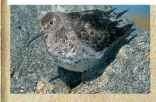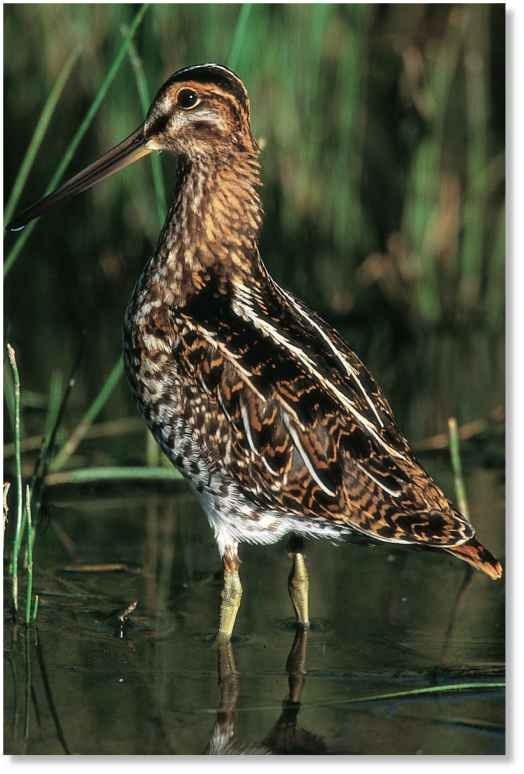ORDER
Charadriiformes
FAMILY
Scolopacidae
GENUS & SPECIES
key features
• A wading bird of shallow marshes and wetlands that uses its long, slender bill to probe for invertebrates
• The male produces a distinctive “winnowing” with his tail feathers during display flights
• Female nests in a depression on the ground and relies on the superb camouflage of her mottled plumage to escape the attention
of predators
where in the world?
Resident in western Europe, South America, the U.S. and southern Africa; migratory elsewhere, breeding in North America, northern Europe and Asia, and wintering farther south
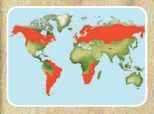
Lifecycle
The common snipe has two highly effective strategies to avoid predators: on the ground, it lies low and relies on superb camouflage; in the air, it flies in a dashing, zigzag flight.
HABITAT
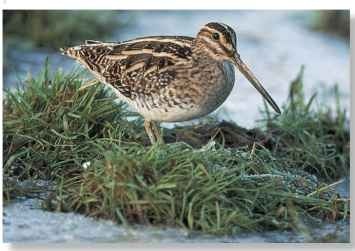
The common snipe is primarily A Soggy ground a bird of waterlogged ground Marshland is a typical as it needs soil soft enough to habitat of the snipe.
let it probe deep beneath the
surface to find food. The rich, spongy ground of peat bogs, water meadows, reedbeds, marshes and flooded fields of scrubby grass are all sought-after habitats during the breeding season. The snipe also requires dense cover nearby, patches of drier ground for nesting and ridges to use as lookout posts.
In winter, the snipe often exploits man-made feeding sites, such as the margins of reservoirs, sewage farms and even muddy pastures churned up by cattle. It visits seashores when frosts freeze the ground hard inland, and in the U.S., many snipe are attracted to feed around some of the warm springs found at higher altitudes.
Snipe have been observed washing mud off food.
# Nests are often rotated between breeding pairs.
In a dive, the snipe’s tail feathers vibrate back and forth 11 times per second, producing a winnowing that can be heard a mile away.
BEHAVIOR
Outside the breeding season, the snipe associates in groups (or “wisps”) of 50 or so birds, but groups of up to 500 may gather at rich feeding grounds.
Most snipe are migratory and begin the journey north to breeding grounds in March. The birds reach their destination in late April or early May
At the end of the breeding season, the snipe concentrates on feeding intensively to build up its energy reserves for its journey south to warmer wintering grounds. It also molts its old flight feathers, growing a new set for the long, arduous flight ahead.The autumn passage south is a slower, more leisurely affair than the spring migration. Some birds set off as early as July but the peak is September It can take some birds many weeks to reach their winter quarters.
^ Cover up A nesting snipe relies on camouflage for safety from predators and is difficult to spot unless it moves.
FOOD & FEEDING
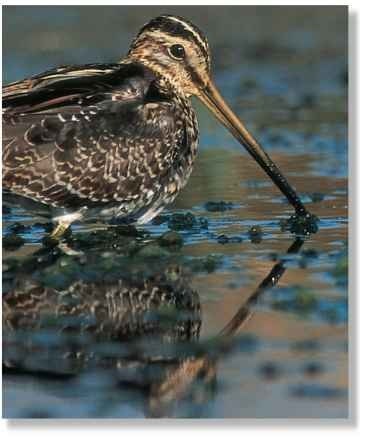
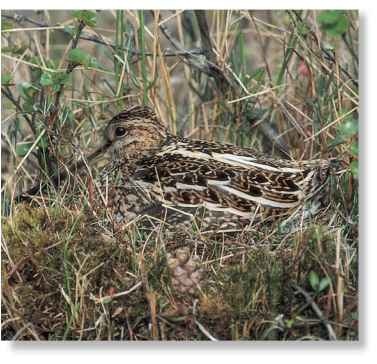
The common snipe is most active at dawn and dusk when it uses its bill to probe for food in the soil. On soft ground, the entire bill is pushed in. Worms form the largest part of the snipe’s diet, but it eats almost any small invertebrate.
Sometimes the snipe walks slowly forward as it probes, but more often it stands rooted to a spot and makes several quick stabs in a semicircle. Small items are eaten before the bill is withdrawn, but large earthworms are pulled free before being swallowed whole.
BILLSTICKER
Aquatic seeds supplement the snipe’s invertebrate diet.
CONSERVATION
The zigzag flight of the common snipe when flushed from cover makes it a challenging target; many are shot for sport and the table. Loss of habitat due to land drainage is causing declines, notably in the south of England, the Netherlands and parts of Scandinavia. Harvesting of peat, especially in Ireland, has also reduced its habitat. But despite these pressures, the snipe remains numerous and, overall, isn’t in danger.
BREEDING
The male is the first to arrive at the breeding grounds and begins his aerial displays to advertise his presence and claim a territory After the arrival of the females, both sexes associate with several partners before firm pair bonds are established.
The nest is a shallow scrape in the ground chosen by the female, who lines it with soft grass and disguises
it with bits of vegetation. Eggs are laid at daily intervals and incubated by the female alone. But the male stays close by and when the chicks hatch, both parents feed them, the male taking charge of the first-hatched chicks while his mate tends the remainder The chicks develop rapidly on their diet of protein-rich worms and other invertebrates and become totally independent within about three weeks.
DRUMMING DISPLAY
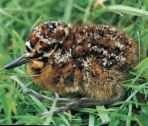
A Early developer Like its parents, a just-hatched young snipe is well camouflaged.
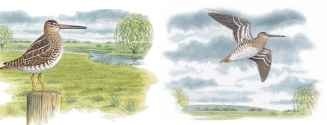
1 Close call…
While his mate is on the nest, the male sits on a perch nearby. He makes a familiar chipping call to reassure her that he’s close.
2 Confirmation…
Like a rocket from a launching pad, he shoots up into the sky to confirm his message of fidelity to the sitting hen.
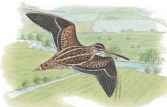
3 Preparation…
Head down, he flies in a widening circle above the nest site. He banks to one side in preparation for a spectacular dive.
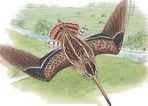
4 Display
With beating wings, the male drops.Air rushing over the stiff outer tail feathers creates a characteristic winnowing sound.
Profile
Common Snipe
The common snipe spends most of its time wading in boggy or marshy sites inland, probing for invertebrates in the soil, using its long bill.
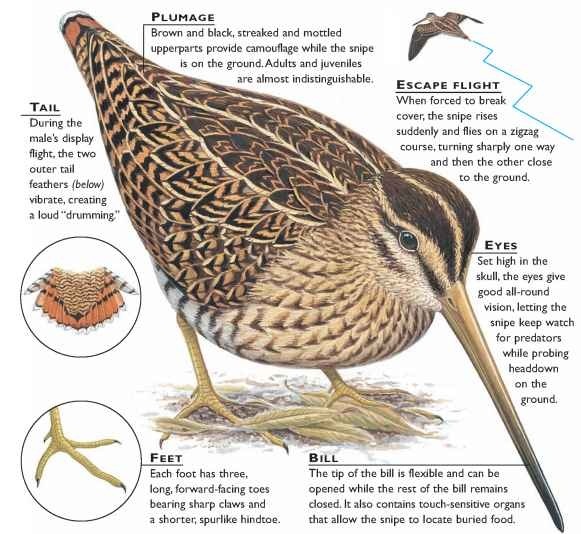
CREATURE COMPARISONS
Common names can often lead to confusion. A good example is the painted snipe (Rostratula benghalensis).Jhe name implies that it’s in the same family as the common snipe, but it’s f actually in its own family, the Rostratulidae. It ives in the same marsh and swampy habitat as the common snipe, its bold pattern breaking up its outline and camouflaging it.The most JK9 Painted unique feature of the painted snipe is that the ^-^^ snlPe female is brightly plumaged and the male is dull.The male also takes over all the nesting duties after the eggs are laid.
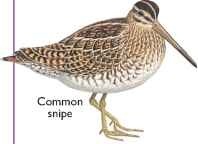

| vital statistics | |
| Weight | 3-4.5 oz. |
| Length | 10-11″ |
| Wingspan | 1.5′ |
| Sexual Maturity | 1-2 years |
| Breeding . Season | April-July |
| Number [ of Eggs | 2-5, usually 4 |
| Incubation Period | 18-20 days |
| Fledging j’ Period | 19-20 days |
| Breeding Interval | 1 year |
| Typical Diet | Mainly worms; also insects, larvae, frogs, mollusks, leeches, aquatic seeds |
| Lifespan | Up to 12 years |
Related species
• The genus Gallinago contains 15 snipe species, including the common snipe, which has several subspecies in both hemispheres. Relations in the family Scolopacidae (86 species in all) include sandpipers, such as the purple sandpiper, Calidris maritima (below).
